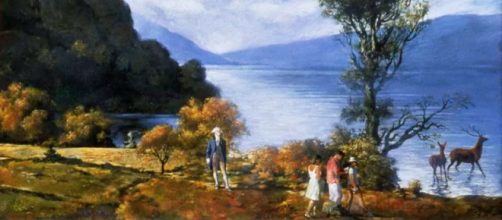The presidential election looms with the knotty question, what do Americans want?
I’m going to cross the Rubicon here and suggest that the question was already answered 30 years ago when a poll asked 1,001 adults to choose things they most want to see in a painting.
Crowd-sourced painting
The upshot was “The Perfect Painting” displayed at the Alternative Museum in Manhattan in 1994. What you saw were America’s forefathers standing by a stilly, sylvan riverside.
Isn’t that the picture Donald Trump paints with his slogan “Make America great again” – stainless, unsullied, pure?
“The Perfect Painting” project was initiated by two Russian-born artists, Vitaly Komar and Alexander Melamid, who set out to identify picture parts that would constitute America’s “most-wanted” in an artwork.
“The Perfect Painting” came with this text: "Imagine an art world governed not by haughty curators and filthy-rich collectors but as a democracy – of, by and for the people.''
If that sounds at all familiar, you’re probably remembering that bucolic innocence was the ideal of the Reich Chancellery in the 1930s. In the words of the Führer: "Art is not a realm unto itself, governed by its own laws. Art must be part of the community.''
Heil Trump!
Seeing himself as the protector of "the right kind of art,'' Adolf Hitler restricted artmaking to Arcadian settings uncontaminated by real life.
"Art,'' he said, "must be cleansed of all manifestations of our rotting world. ...The artist does not create for himself. He creates for the people and we will see to it henceforth that the people will be called in to judge it art.''
Isn’t that what happened last year in Tallahassee, Florida? A school principal was fired for not informing parents that their sixth-grade children would study Michelangelo's “David” in their art class. The parents decried the statue as “pornography.”
More censorship can be expected in Trump second term. One of his announced plans is a remaking of America’s education system in the MAGA image. Rolling Stone points to Trump’s vow to cut funding “for any school pushing sexual content on children.”
The Führer had a similar idea when he blacklisted 16,500 artworks.
A list of those he censored was found in 1996 in England that Hitler tagged "degenerate.''
The blacklisted artists included Cézanne, Van Gogh, Gauguin, Matisse and Picasso. Given the Tallahassee incident, Trump’s education department would likely blacklist Michelangelo.
Yet, not even Hitler's minister of public education, Joseph Goebbels, thought that allowing only uplifting art to the exclusion of all other was a good idea. In his words: "To have only classicism on the one hand and harmless trivialization on the other is not enough for our time.''
What would be “enough” for a time more unruly than ever. Certainly not some unsullied mise-en-scene. There’s no going back. I’m thinking of a passage in Dong Thu Huong’s 1995 book "Novel Without a Name." "There is no way back to the source, to the place where the pure, clear water once gushed forth. The river has cut across the countryside, the town, dragging refuse and mud in its wake." Donald Trump, please copy.


